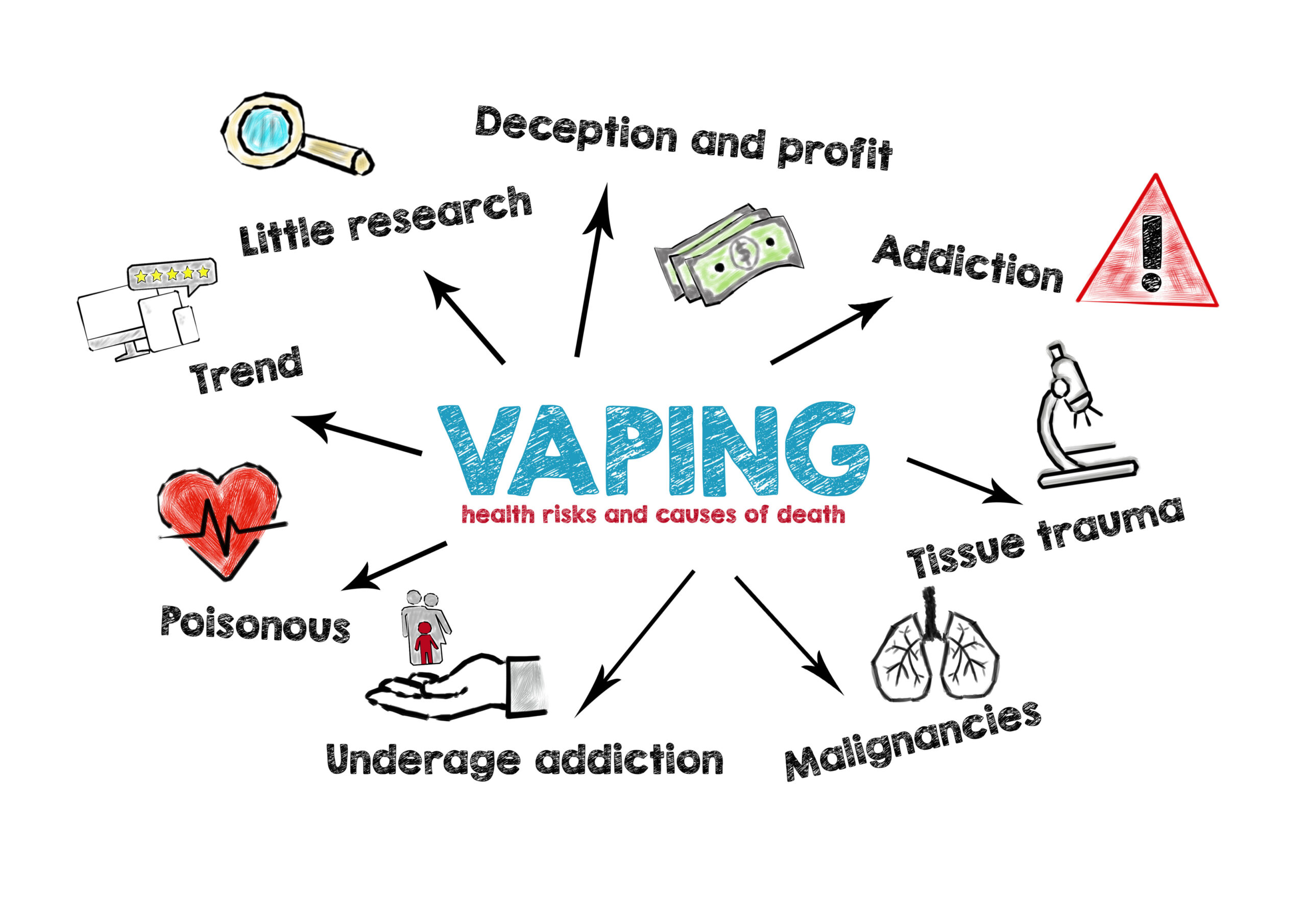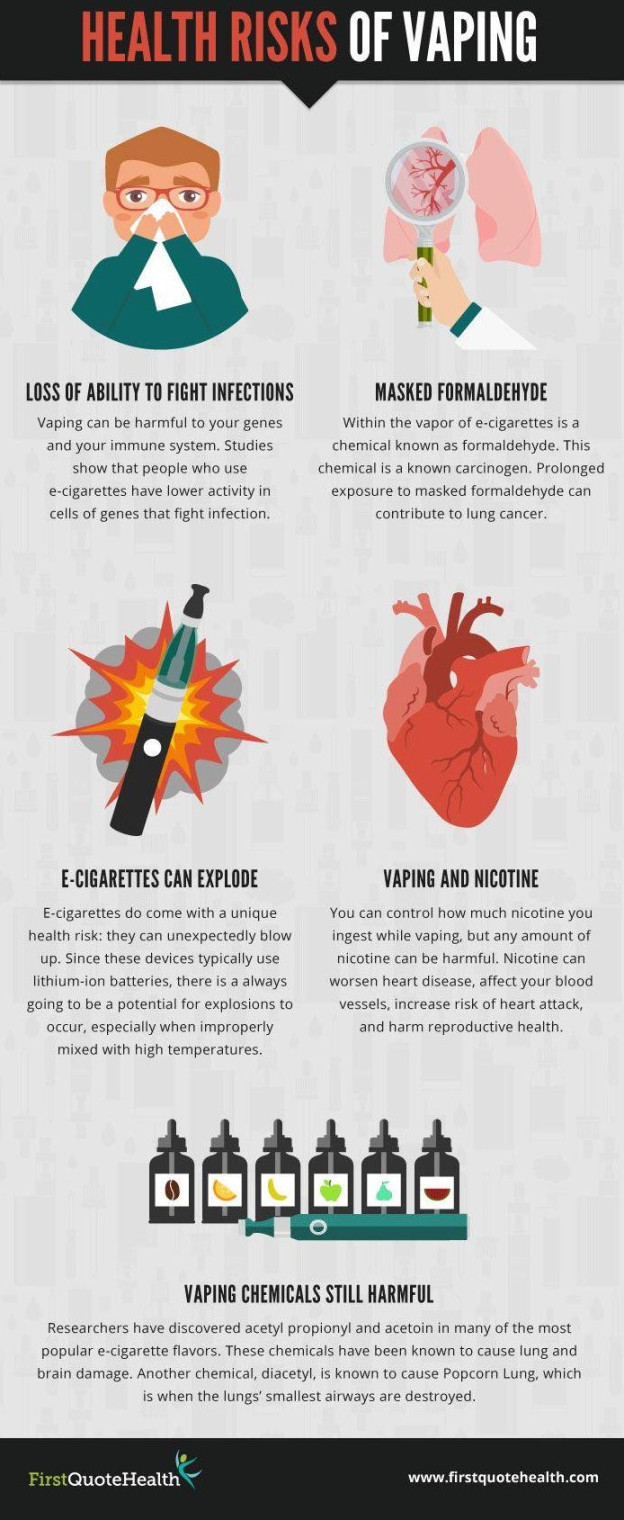Nicotine Addiction
Vaping, often touted as a safer alternative to traditional cigarettes, has gained immense popularity in recent years. While it may seem like a harmless habit, there are significant health risks associated with vaping. One of the most concerning downsides is nicotine addiction.
Nicotine, the addictive substance found in both cigarettes and vaping devices, can have a powerful grip on users. When inhaled, nicotine enters the bloodstream quickly, reaching the brain within seconds. This rapid absorption can lead to a strong sense of pleasure and relaxation. Over time, repeated exposure to nicotine can cause the brain to become dependent on it, making it difficult to quit.

Nicotine addiction can have far-reaching consequences. It can interfere with daily life, making it challenging to focus on work, school, or relationships. It can also lead to mood swings, irritability, and anxiety. Additionally, nicotine addiction can increase the risk of developing other substance abuse problems, such as alcohol or drug addiction.
While vaping may not involve the same level of tar and carbon monoxide as traditional cigarettes, it still delivers nicotine, which can be highly addictive. Therefore, it’s crucial to be aware of the potential for nicotine addiction when considering vaping.
Understanding the Mechanics of Nicotine Addiction

To fully grasp the dangers of nicotine addiction, it’s important to understand how it works. Nicotine acts on the brain’s reward system, releasing dopamine, a neurotransmitter associated with pleasure and reward. When nicotine is inhaled, it binds to receptors in the brain, triggering the release of dopamine. This surge of dopamine creates a feeling of satisfaction and euphoria.
Over time, repeated exposure to nicotine can cause the brain to adapt to the increased levels of dopamine. As a result, the brain becomes less sensitive to the effects of nicotine, leading to tolerance. This means that users may need to vape more frequently or use higher nicotine concentrations to achieve the same level of satisfaction.
Additionally, nicotine can interfere with the brain’s natural dopamine production. When nicotine is present, the brain may reduce its own dopamine production, leading to a dependence on the external source of nicotine. This dependence can make it difficult to quit vaping, even when users recognize the negative consequences.
The Psychological Impact of Nicotine Addiction
Nicotine addiction can have a significant psychological impact on individuals. It can lead to feelings of anxiety, depression, and irritability. Users may experience cravings for nicotine, which can be intense and difficult to resist. These cravings can interfere with daily activities and relationships, making it challenging to cope with stress and maintain a healthy lifestyle.
Moreover, nicotine addiction can contribute to a cycle of negative emotions and behaviors. When users are unable to satisfy their nicotine cravings, they may experience feelings of frustration, anger, or guilt. These negative emotions can, in turn, lead to unhealthy coping mechanisms, such as increased vaping or substance abuse.
It’s important to remember that nicotine addiction is a complex issue with both physical and psychological components. While it may seem like a harmless habit, the long-term consequences can be significant. Understanding the mechanics of nicotine addiction and the psychological impact it can have is essential for making informed decisions about vaping.
2. Potential for Addiction
Vaping, often touted as a safer alternative to traditional cigarettes, has gained significant popularity in recent years. However, while it may be less harmful than smoking, vaping is not without its risks. One of the primary concerns is the potential for addiction.
Nicotine, the addictive substance found in both cigarettes and vaping products, can be highly habit-forming. When inhaled, nicotine stimulates the brain’s reward system, releasing dopamine, a neurotransmitter associated with pleasure and satisfaction. This pleasurable sensation can lead to dependence, making it difficult for users to quit.
While vaping may not involve the same level of tar and carbon monoxide as traditional cigarettes, it still delivers nicotine directly to the lungs. This exposure can lead to the development of nicotine addiction, especially among young people who are particularly susceptible to the effects of the substance.
In addition to the physical dependence, vaping can also contribute to psychological addiction. Users may develop a strong association between vaping and certain activities, emotions, or social situations. This can make it challenging to quit, even when individuals recognize the negative health consequences.
It’s important to note that the level of addiction potential can vary depending on the vaping product and the individual’s vaping habits. Products with higher nicotine concentrations or those that are used more frequently may increase the risk of addiction.
While vaping may be perceived as a less harmful alternative to smoking, it’s essential to acknowledge the potential for addiction. Understanding the addictive nature of nicotine can help individuals make informed decisions about their vaping habits and take steps to prevent or overcome addiction.
 Udento Lifestyle & Health
Udento Lifestyle & Health




